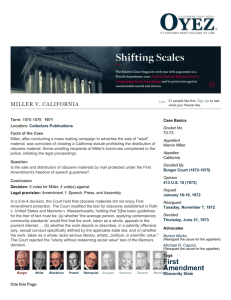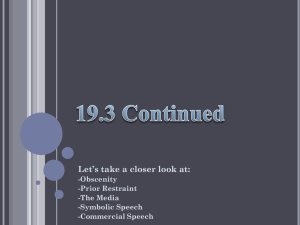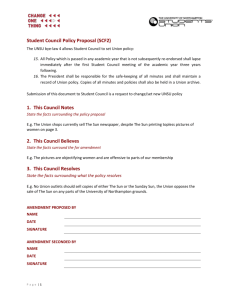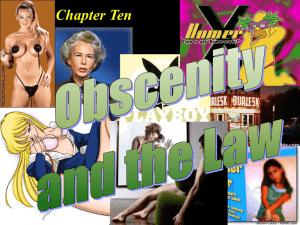Miller v. California
advertisement
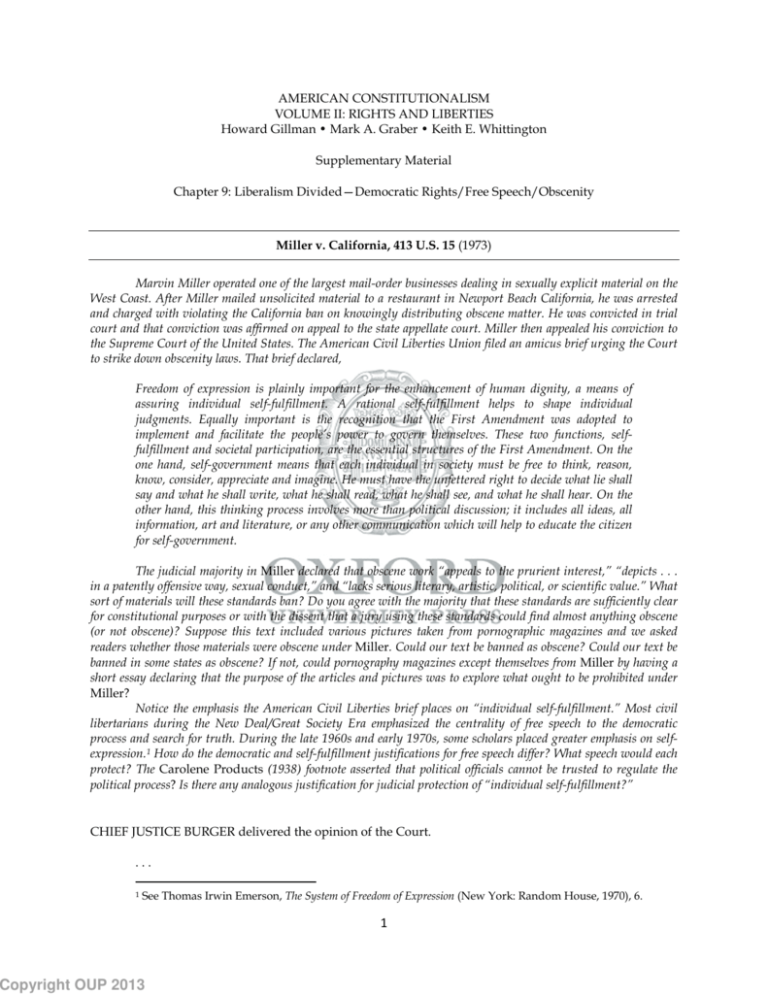
AMERICAN CONSTITUTIONALISM VOLUME II: RIGHTS AND LIBERTIES Howard Gillman • Mark A. Graber • Keith E. Whittington Supplementary Material Chapter 9: Liberalism Divided—Democratic Rights/Free Speech/Obscenity Miller v. California, 413 U.S. 15 (1973) Marvin Miller operated one of the largest mail-order businesses dealing in sexually explicit material on the West Coast. After Miller mailed unsolicited material to a restaurant in Newport Beach California, he was arrested and charged with violating the California ban on knowingly distributing obscene matter. He was convicted in trial court and that conviction was affirmed on appeal to the state appellate court. Miller then appealed his conviction to the Supreme Court of the United States. The American Civil Liberties Union filed an amicus brief urging the Court to strike down obscenity laws. That brief declared, Freedom of expression is plainly important for the enhancement of human dignity, a means of assuring individual self-fulfillment. A rational self-fulfillment helps to shape individual judgments. Equally important is the recognition that the First Amendment was adopted to implement and facilitate the people’s power to govern themselves. These two functions, selffulfillment and societal participation, are the essential structures of the First Amendment. On the one hand, self-government means that each individual in society must be free to think, reason, know, consider, appreciate and imagine. He must have the unfettered right to decide what lie shall say and what he shall write, what he shall read, what he shall see, and what he shall hear. On the other hand, this thinking process involves more than political discussion; it includes all ideas, all information, art and literature, or any other communication which will help to educate the citizen for self-government. The judicial majority in Miller declared that obscene work “appeals to the prurient interest,” “depicts . . . in a patently offensive way, sexual conduct,” and “lacks serious literary, artistic, political, or scientific value.” What sort of materials will these standards ban? Do you agree with the majority that these standards are sufficiently clear for constitutional purposes or with the dissent that a jury using these standards could find almost anything obscene (or not obscene)? Suppose this text included various pictures taken from pornographic magazines and we asked readers whether those materials were obscene under Miller. Could our text be banned as obscene? Could our text be banned in some states as obscene? If not, could pornography magazines except themselves from Miller by having a short essay declaring that the purpose of the articles and pictures was to explore what ought to be prohibited under Miller? Notice the emphasis the American Civil Liberties brief places on “individual self-fulfillment.” Most civil libertarians during the New Deal/Great Society Era emphasized the centrality of free speech to the democratic process and search for truth. During the late 1960s and early 1970s, some scholars placed greater emphasis on selfexpression.1 How do the democratic and self-fulfillment justifications for free speech differ? What speech would each protect? The Carolene Products (1938) footnote asserted that political officials cannot be trusted to regulate the political process? Is there any analogous justification for judicial protection of “individual self-fulfillment?” CHIEF JUSTICE BURGER delivered the opinion of the Court. ... 1 See Thomas Irwin Emerson, The System of Freedom of Expression (New York: Random House, 1970), 6. Copyright OUP 2013 1 This much has been categorically settled by the Court, that obscene material is unprotected by the First Amendment. . . . We acknowledge, however, the inherent dangers of undertaking to regulate any form of expression. State statutes designed to regulate obscene materials must be carefully limited. . . . As a result, we now confine the permissible scope of such regulation to works which depict or describe sexual conduct. That conduct must be specifically defined by the applicable state law, as written or authoritatively construed. A state offense must also be limited to works which, taken as a whole, appeal to the prurient interest in sex, which portray sexual conduct in a patently offensive way, and which, taken as a whole, do not have serious literary, artistic, political, or scientific value. The basic guidelines for the trier of fact must be: (a) whether ‘the average person, applying contemporary community standards’ would find that the work, taken as a whole, appeals to the prurient interest. . . ; (b) whether the work depicts or describes, in a patently offensive way, sexual conduct specifically defined by the applicable state law; and (c) whether the work, taken as a whole, lacks serious literary, artistic, political, or scientific value. We do not adopt as a constitutional standard the ‘utterly without redeeming social value’ test of Memoirs v. Massachusetts (1966). . . ; that concept has never commanded the adherence of more than three Justices at one time. . . . If a state law that regulates obscene material is thus limited, as written or construed, the First Amendment values applicable to the States through the Fourteenth Amendment are adequately protected by the ultimate power of appellate courts to conduct an independent review of constitutional claims when necessary. ... Sex and nudity may not be exploited without limit by films or pictures exhibited or sold in places of public accommodation any more than live sex and nudity can be exhibited or sold without limit in such public places. At a minimum, prurient, patently offensive depiction or description of sexual conduct must have serious literary, artistic, political, or scientific value to merit First Amendment protection. . . . In resolving the inevitably sensitive questions of fact and law, we must continue to rely on the jury system, accompanied by the safeguards that judges, rules of evidence, presumption of innocence, and other protective features provide, as we do with rape, murder, and a host of other offenses against society and its individual members. ... Under a National Constitution, fundamental First Amendment limitations on the powers of the States do not vary from community to community, but this does not mean that there are, or should or can be, fixed, uniform national standards of precisely what appeals to the ‘prurient interest’ or is ‘patently offensive.’ These are essentially questions of fact, and our Nation is simply too big and too diverse for this Court to reasonably expect that such standards could be articulated for all 50 States in a single formulation, even assuming the prerequisite consensus exists. When triers of fact are asked to decide whether ‘the average person, applying contemporary community standards’ would consider certain materials ‘prurient,’ it would be unrealistic to require that the answer be based on some abstract formulation. The adversary system, with lay jurors as the usual ultimate factfinders in criminal prosecutions, has historically permitted triers of fact to draw on the standards of their community, guided always by limiting instructions on the law. To require a State to structure obscenity proceedings around evidence of a national ‘community standard’ would be an exercise in futility. ... It is neither realistic nor constitutionally sound to read the First Amendment as requiring that the people of Maine or Mississippi accept public depiction of conduct found tolerable in Las Vegas, or New York City. . . . People in different States vary in their tastes and attitudes, and this diversity is not to be strangled by the absolutism of imposed uniformity. . . . [T]he primary concern with requiring a jury to apply the standard of ‘the average person, applying contemporary community standards’ is to be certain that, so far as material is not aimed at a deviant group, it will be judged by its impact on an average person, rather than a particularly susceptible or sensitive person—or indeed a totally insensitive one. ... The dissenting Justices sound the alarm of repression. But, in our view, to equate the free and robust exchange of ideas and political debate with commercial exploitation of obscene material demeans the grand conception of the First Amendment and its high purposes in the historic struggle for freedom. . Copyright OUP 2013 2 . . The First Amendment protects works which, taken as a whole, have serious literary, artistic, political, or scientific value, regardless of whether the government or a majority of the people approve of the ideas these works represent. . . . But the public portrayal of hard-core sexual conduct for its own sake, and for the ensuing commercial gain, is a different matter. There is no evidence, empirical or historical, that the stern 19th century American censorship of public distribution and display of material relating to sex . . . in any way limited or affected expression of serious literary, artistic, political, or scientific ideas. On the contrary, it is beyond any question that the era following Thomas Jefferson to Theodore Roosevelt was an ‘extraordinarily vigorous period,’ not just in economics and politics, but in belles lettres and in ‘the outlying fields of social and political philosophies.’ We do not see the harsh hand of censorship of ideas—good or bad, sound or unsound—and ‘repression’ of political liberty lurking in every state regulation of commercial exploitation of human interest in sex. ... JUSTICE DOUGLAS, dissenting. . . . The Court has worked hard to define obscenity and concededly has failed. ... Today we would add a new three-pronged test: ‘(a) whether ‘the average person, applying contemporary community standards’ would find that the work, taken as a whole, appeals to the prurient interest, . . . (b) whether the work depicts or describes, in a patently offensive way, sexual conduct specifically defined by the applicable state law, and (c) whether the work, taken as a whole, lacks serious literary, artistic, political, or scientific value.’ Those are the standards we ourselves have written into the Constitution. Yet how under these vague tests can we sustain convictions for the sale of an article prior to the time when some court has declared it to be obscene? ... Today the Court retreats from the earlier formulations of the constitutional test and undertakes to make new definitions. This effort, like the earlier ones, is earnest and well intentioned. The difficulty is that we do not deal with constitutional terms, since ‘obscenity’ is not mentioned in the Constitution or Bill of Rights. And the First Amendment makes no such exception from ‘the press’ which it undertakes to protect nor, as I have said on other occasions, is an exception necessarily implied, for there was no recognized exception to the free press at the time the Bill of Rights was adopted which treated ‘obscene’ publications differently from other types of papers, magazines, and books. So there are no constitutional guidelines for deciding what is and what is not ‘obscene.’ ... If a specific book, play, paper, or motion picture has in a civil proceeding been condemned as obscene and review of that finding has been completed, and thereafter a person publishers, shows, or displays that particular book or film, then a vague law has been made specific. There would remain the underlying question whether the First Amendment allows an implied exception in the case of obscenity. I do not think it does and my views on the issue have been stated over and over again. But at least a criminal prosecution brought at that juncture would not violate the time-honored void-for-vagueness test. No such protective procedure has been designed by California in this case. Obscenity—which even we cannot define with precision—is a hodge-podge. To send *44 men to jail for violating standards they cannot understand, construe, and apply is a monstrous thing to do in a Nation dedicated to fair trials and due process. The idea that the First Amendment permits government to ban publications that are ‘offensive’ to some people puts an ominous gloss on freedom of the press. That test would make it possible to ban any paper or any journal or magazine in some benighted place. The First Amendment was designed ‘to invite dispute,’ to induce ‘a condition of unrest,’ to ‘create dissatisfaction with conditions as they are,’ and even to stir ‘people’ to anger.’ . . . The idea that the First Amendment permits punishment for ideas that are ‘offensive’ to the particular judge or jury sitting in judgment is astounding. No greater leveler of speech Copyright OUP 2013 3 or literature has ever been designed. To give the power to the censor, as we do today, is to make a sharp and radical break with the traditions of a free society. The First Amendment was not fashioned as a vehicle for dispensing tranquilizers to the people. Its prime function was to keep debate open to ‘offensive’ as well as to ‘staid’ people. The tendency throughout history has been to subdue the individual and to exalt the power of government. The use of the standard ‘offensive’ gives authority to government that cuts the very vitals out of the First Amendment. As is intimated by the Court’s opinion, the materials before us may be garbage. But so is much of what is said in political campaigns, in the daily press, on TV, or over the radio. By reason of the First Amendment—and solely because of it—speakers and publishers have not been threatened or subdued because their thoughts and ideas may be ‘offensive’ to some. JUSTICE BRENNAN, with whom JUSTICE STEWART and JUSTICE MARSHALL join, dissenting. [Justice Brennan urged a new trial on the basis of his opinion in Paris Adult Theater I v. Slaton (1973).] Copyright OUP 2013 4
